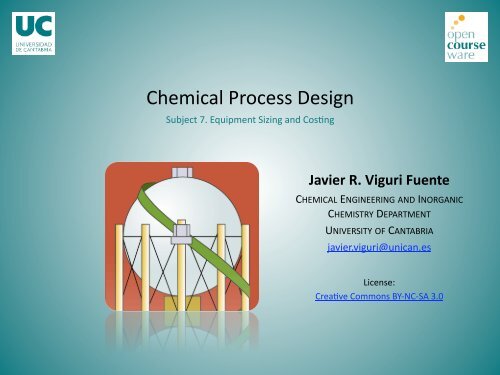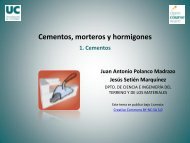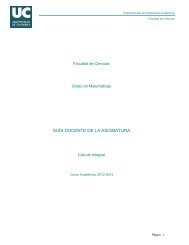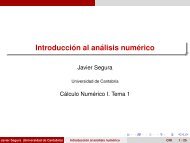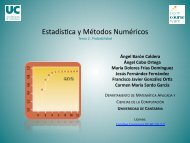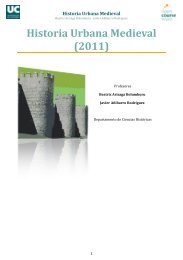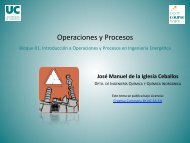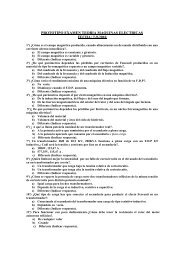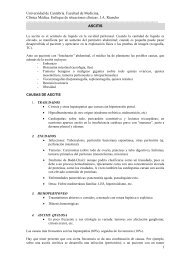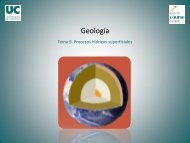Chemical Process Design
Chemical Process Design
Chemical Process Design
Create successful ePaper yourself
Turn your PDF publications into a flip-book with our unique Google optimized e-Paper software.
<strong>Chemical</strong> <strong>Process</strong> <strong>Design</strong> <br />
Subject 7. Equipment Sizing and Cos8ng <br />
Javier R. Viguri Fuente <br />
CHEMICAL ENGINEERING AND INORGANIC <br />
CHEMISTRY DEPARTMENT <br />
UNIVERSITY OF CANTABRIA <br />
javier.viguri@unican.es <br />
License: <br />
Crea8ve Commons BY‐NC‐SA 3.0
INDEX<br />
1.- Introduction<br />
• Categories of total capital cost estimates<br />
• Cost estimation method of Guthrie<br />
2.- Short cuts for equipment sizing procedures<br />
• Vessel (flash drums, storage tanks, decanters and some reactors)<br />
• Reactors<br />
• Heat transfer equipment (heat exchangers, furnaces and direct fired heaters)<br />
• Distillation columns<br />
• Absorbers columns<br />
• Compressors (or turbines)<br />
• Pumps<br />
• Refrigeration<br />
3.- Cost estimation of equipment<br />
• Base costs for equipment units<br />
• Guthrie´s modular method<br />
4.- Further Reading and References<br />
2
1.- INTRODUCTION<br />
<strong>Process</strong> Alternatives Synthesis (candidate flowsheet)<br />
Analysis (Preliminary mass and energy balances)<br />
SIZING (Sizes and capacities)<br />
COST ESTIMATION (Capital and operation)<br />
Economic Analysis (economic criteria)<br />
SIZING<br />
Calculation of all physical attributes that allow a unique costing of this unit<br />
- Capacity, Height - Pressure rating<br />
-Cross sectional area – Materials of construction<br />
Short-cut, approximate calculations (correlations) Quick obtaining of<br />
sizing parameters Order of magnitude estimated parameters<br />
COST<br />
Total Capital Investment or Capital Cost: Function of the process<br />
equipment The sized equipment will be costed<br />
* Approximate methods to estimate costs<br />
Manufacturing Cost: Function of process equipment and utility charges<br />
3
Categories of total capital cost estimates<br />
based on accuracy of the estimate<br />
ESTIMATE BASED ON Error (%) Obtention USED TO<br />
ORDER OF<br />
MAGNITUDE<br />
(Ratio estimate)<br />
STUDY<br />
PRELIMINARY<br />
DEFINITIVE<br />
Method of Hill, 1956. Production rate<br />
and PFD with compressors, reactors<br />
and separation equipments. Based<br />
on similar plants.<br />
Overall Factor Method of Lang, 1947.<br />
Mass & energy balance and<br />
equipment sizing.<br />
Individual Factors Method of Guthrie,<br />
1969, 1974. Mass & energy balance,<br />
equipment sizing, construction<br />
materials and P&ID. Enough data to<br />
budget estimation.<br />
Full data but before drawings and<br />
specifications.<br />
40 - 50 Very fast Profitability<br />
analysis<br />
25 - 40 Fast<br />
15 - 25 Medium<br />
10 -15 Slow<br />
DETAILED Detailed Engineering 5 -10 Very slow<br />
Preliminary<br />
design<br />
Budget<br />
approval<br />
Construction<br />
control<br />
Turnkey<br />
contract<br />
4
Cost Estimation Method of Guthrie<br />
• Equipment purchase cost: Graphs and/or equations.<br />
Based on a power law expression: Williams Law C = BC =Co (S/So) α <br />
Economy of Scale (incremental cost C, decrease with larger capacities S)<br />
Based on a polynomial expression BC = exp {A 0 + A 1 [ln (S)] + A 2 [ln (S) ] 2 +…}<br />
• Installation: Module Factor, MF, affected by BC, taking into account<br />
labor, piping instruments, accessories, etc.<br />
Typical Value of MF=2.95 equipment cost is almost 3 times the BC.<br />
Installation = (BC)(MF)-BC = BC(MF-1)<br />
• For special materials, high pressures and special designs abroad base<br />
capacities and costs (Co, So), the Materials and Pressure correction<br />
Factors, MPF, are defined.<br />
Uninstalled Cost = (BC)(MPF) Total Installed Cost = BC (MPF+MF-1)<br />
• To update cost from mid-1968, an Update Factor, UF to account for<br />
inflation is apply.<br />
UF: Present Cost Index/Base Cost index<br />
Updated bare module cost: BMC = UF(BC) (MPF+MF-1)<br />
5
Materials and Pressure correction Factors: MPF<br />
Empirical factors that modified BC and evaluate particular instances of<br />
equipment beyond a basic configuration: Uninstalled Cost = (BC x MPF)<br />
MPF = Φ Φ (Fd, Fm, Fp, Fo, Ft)<br />
Fd: <strong>Design</strong> variation Fm: Construction material variation<br />
Fp: Pressure variation Fo: Operating Limits ( Φ Φ of T, P)<br />
Ft: Mechanical refrigeration factor Φ Φ Φ ( (T ( evaporator)<br />
EQUIPMENT MPF<br />
Pressure Vessels Fm . Fp<br />
Heat Exchangers Fm (Fp + Fd)<br />
Furnaces, direct fired heaters, Tray stacks Fm + Fp + Fd<br />
Centrifugal pumps Fm . Fo<br />
Compressors Fd<br />
Equipment Sizing Procedures<br />
Need C and MPF required the flowsheet mass and energy balance<br />
(Flow, T, P, Q)<br />
6
An example of Cost Estimation<br />
Equipment<br />
purchase price<br />
<strong>Design</strong> Factor<br />
Fd<br />
Cp<br />
Total Cost =<br />
UF<br />
Material Factor<br />
Fm<br />
Pressure<br />
Factor<br />
Fp<br />
Factor Base<br />
Modular<br />
Fbm<br />
7
2.- EQUIPMENT SIZING PROCEDURES<br />
Q, P<br />
maintenance<br />
∆ Heat<br />
contents<br />
∆<br />
Composition<br />
Q, P<br />
streams<br />
setting<br />
Vessels<br />
V<br />
Heat transfer equipment: Heat exchangers<br />
Furnaces and Direct Fired Heaters<br />
Refrigeration<br />
Reactors<br />
Columns, distillation and Absorption<br />
Pumps, Compressors and Turbines<br />
Short-cut calculations<br />
for the main<br />
equipment sizing<br />
5<br />
P1<br />
H1IN<br />
D1<br />
CT<br />
C1<br />
HX1<br />
C1<br />
8
SHORTCUTS for VESSEL SIZING (Flash drums, storage tanks, decanters and<br />
some reactors)<br />
1) Select the V for liquid holdup; τ= 5 min + equal vapor volume<br />
V=(F L /ρ L * τ)*2<br />
2) Select L=4D<br />
•Materials of Construction appropriate to use with the Guthrie´s factors<br />
and pressure (P rated =1.5 P actual )<br />
• Basic Configuration for pressure vessels<br />
F<br />
V=πD 2 /4*L D=(V/π) 1/3 ; If D ≤1.2 m Vertical, else Horizontal<br />
V<br />
FV<br />
- Carbon steel vessel with 50 psig design P and average nozzles and manways<br />
- Vertical construction includes shell and two heads, the skirt, base rings and lugs, and<br />
possible tray supports.<br />
- Horizontal construction includes shell, two heads and two saddles<br />
MPF = Fm . Fp; Fm depending shell material configuration (clad or solid)<br />
FL<br />
V<br />
V2<br />
9
High Temperature Service<br />
Tmax ( o F) Steel<br />
950 Carbon steel (CS)<br />
1150 502 stainless steels (SS)<br />
1300 410 SS; 330 SS<br />
1500 304,321,347,316 SS.<br />
Hastelloy C, X Inconel<br />
Materials of Construction for Pressure Vessels<br />
2000 446 SS, Cast stainless, HC<br />
Low Temperature Service<br />
Tmin ( o F) Steel<br />
-50 Carbon steel (CS)<br />
-75 Nickel steel (A203)<br />
-320 Nickel steel (A353)<br />
-425 302,304,310,347 (SS)<br />
Guthrie Material and pressure factors for pressure vessels: MPF = Fm Fp<br />
Shell Material Clad, Fm Solid, Fm<br />
Carbon Steel (CS) 1.00 1.00<br />
Stainless 316 (SS) 2.25 3.67<br />
Monel (Ni:Cr/2:1 alloy) 3.89 6.34<br />
Titanium 4.23 7.89<br />
Vessel Pressure (psig)<br />
Up to 50 100 200 300 400 500 900 1000<br />
Fp 1.00 1.05 1.15 1.20 1.35 1.45 2.30 2.50<br />
10
SHORT CUT for REACTORS SIZING<br />
First step of the preliminary design Not kinetic model available.<br />
Mass Balance based on Product distribution High influence in final cost<br />
Assumptions: Reactor equivalent to laboratory reactor, adiabatic reactors<br />
are isotherm at average T.<br />
Assume space velocity (S in h -1 )<br />
S = (1/τ) = µ µ /ρ /ρ Vcat ; V = Vcat / 1- ε<br />
µ = Flow rate; ρ= molar density; V cat= Volume of catalyst; ε= Void fraction of catalyst (e.g. ε=0.5)<br />
5<br />
R<br />
1<br />
R2<br />
11
HEAT TRANSFER EQUIPMENT SIZING<br />
Heat exchanger types used in chemical process<br />
By function<br />
- Refrigerants (air or water) - Condensers (v, v+l l) - Reboilers, vaporizers (lv) - Exchangers in general<br />
By constructive shape<br />
- Double pipe exchanger: the simplest one - Shell and tube exchangers: used for all applications<br />
- Plate and frame exchangers - Air cooled: used for coolers and condensers<br />
- Direct contact: used for cooling and quenching - Jacketed vessels, agitated vessels and internal coils<br />
- Fired heaters: Furnaces and boilers<br />
Shell and tube countercurrent exchanger, steady state<br />
Q = U A ∆T lm<br />
Q: From the energy balance<br />
U: Estimation of heat transfer coefficient. Depending on configuration and media used<br />
in the Shell and Tube side: L-L, Condensing vapor-L, Gas-L, Vaporizers). (Perry's<br />
Handbook, 2008; www.tema.org).<br />
A: Area<br />
∆T lm : Logarithmic Mean ∆T = (T1-t2)-(T2-t1)/ln (T1-t2/T2-t1)<br />
- If phase changes Approximation of 2 heat exchangers (A=A1+A2)<br />
- Maximum area A ≤ 1000 m 2 , else Parallel HX<br />
MPF: Fm (Fp + Fd)<br />
H1<br />
C11<br />
T1 T2<br />
t2<br />
EX1<br />
t1<br />
H11<br />
C1<br />
12
Heat exchanger: Countercurrent, steady state HX1<br />
Guthrie Material and pressure factors for Heat Exchangers: MPF: Fm (Fp + Fd)<br />
<strong>Design</strong> Type Fd Vessel Pressure (psig)<br />
Kettle Reboiler 1.35<br />
Floating Head 1.00 Up to 150 300 400 800 1000<br />
U Tube 0.85 Fp 0.00 0.10 0.25 0.52 0.55<br />
Fixed tube sheet 0.80<br />
Shell/Tube Materials, Fm<br />
Surface Area (ft 2 ) CS/ CS/ CS/ SS/ CS/ Monel CS/ Ti/<br />
CS Brass SS SS Monel Monel Ti Ti<br />
Up to 100 1.00 1.05 1.54 2.50 2.00 3.20 4.10 10.28<br />
100 to 500 1.00 1.10 1.78 3.10 2.30 3.50 5.20 10.60<br />
500 to 1000 1.00 1.15 2.25 3.26 2.50 3.65 6.15 10.75<br />
1000 to 5000 1.00 1.30 2.81 3.75 3.10 4.25 8.95 13.05<br />
13
FURNACES and DIRECT FIRED HEATERS (boilers,reboilers, pyrolysis, reformers)<br />
Q = Absorbed duty from heat balance<br />
• Radiant section (q r =37.6 kW/m 2 heat flux) + Convection section (q c =12.5 kW/m 2<br />
heat flux). Equal heat transmission (kW) A rad =0.5 x kW/q r ; A conv =0.5 x kW/q c<br />
• Basic configuration for furnaces is given by a process heater with a box or Aframe<br />
construction, carbon steel tubes, and a 500 psig design P. This includes<br />
complete field erection.<br />
• Direct fired heaters is given by a process heater with cylindrical construction,<br />
carbon steel tubes, and a 500 psig design.<br />
Guthrie MPF for Furnaces: MPF= Fm+Fp+Fd<br />
<strong>Design</strong> Type Fd<br />
<strong>Process</strong> Heater 1.00<br />
Pyrolisis 1.10<br />
Reformer 1.35<br />
Vessel Pressure (psig)<br />
Up to 500 1000 1500 2000 2500 3000<br />
Fp 0.00 0.10 0.15 0.25 0.40 0.60<br />
Radiant Tube Material, Fm<br />
Carbon Steel 0.00<br />
Chrome/Moly 0.35<br />
Stainless Steel 0.75<br />
Guthrie MPF for Direct Fired Heaters<br />
MPF: Fm + Fp + Fd<br />
<strong>Design</strong> Type Fd<br />
Cylindrical 1.00<br />
Dowtherm 1.33<br />
Vessel Pressure (psig)<br />
Up to 500 1000 1500<br />
Fp 0.00 0.15 0.20<br />
Radiant Tube Material, Fm<br />
Carbon Steel 0.00<br />
Chrome/Moly 0.45<br />
Stainless Steel 0.50<br />
14
HEAT EXCHANGERS<br />
15
SHORT CUT for DISTILLATION COLUMS SIZING<br />
Fenske's equation applies to any two components lk and hk at infinite reflux and is<br />
defined by N min , where αij is the geometric mean of the α's at the T of the feed,<br />
distillate and the bottoms.<br />
( α )<br />
lk / hk<br />
R min is given by Underwood with two equations that must be solved, where q is<br />
the liquid fraction in the feed..<br />
Gilliland used an empirical correlation to<br />
calculate the final number of stage N from<br />
the values calculated through the Fenske<br />
and Underwood equations (N min , R, R min ).<br />
The procedure use a diagram; one enters<br />
with the abscissa value known, and read<br />
the ordinate of the corresponding point on<br />
the Gilliland curve. The only unknown of<br />
the ordinate is the number of stage N.<br />
⎛ x Dlk / x ⎞ Blk<br />
log ⎜⎜<br />
x Dhk / x ⎟⎟<br />
Bhk<br />
N min =<br />
⎝<br />
⎠<br />
α lk / hk = D lk / hk F lk / hkα<br />
log<br />
( ) 3 / 1<br />
α α<br />
B lk / hk<br />
16
SHORT CUT for DISTILLATION COLUMS SIZING<br />
Simple and direct correlation for (nearly) ideal systems (Westerberg, 1978)<br />
• Determine α lk/hk ; β lk = ξ lk ; β hk = 1- ξ hk<br />
• Calculate tray number Ni and reflux ratio Ri from correlations (i= lk, hk):<br />
Ni = 12.3 / (α lk/hk -1) 2/3 . (1- β i ) 1/6 Ri = 1.38 / (α lk/hk -1) 0.9 . (1- β i ) 0.1<br />
- Theoretical nº of trays N T = 0.8 max[Ni] + 0.2 min[Ni]; R= 0.8 max[Ri] + 0.2 min[Ri]<br />
- Actual nº of trays N = N T /0.8<br />
- For H consider 0.6 m spacing (H=0.6 N); Maximum H=60 m else, 2 columns<br />
* Calculate column diameter, D, by internal flowrates and taking into account<br />
the vapor fraction of F. Internal flowrates used to sizing condenser, reboiler<br />
<strong>Design</strong> column at 80% of linear flooding velocity<br />
π D<br />
A =<br />
4<br />
2<br />
⎡ V ⎤<br />
= ⎢<br />
⎥<br />
⎢⎣<br />
0.<br />
8U<br />
f ε ρG<br />
⎥⎦<br />
If D> 3m Parallel columns<br />
* Calculate heat duties for reboiler and condenser<br />
n<br />
n<br />
k k k V<br />
k<br />
∑(<br />
µ<br />
D + µ L ) ∆H<br />
vap = µ dk H<br />
Q ∆<br />
cond = HV<br />
− H L =<br />
∑<br />
k=<br />
1<br />
D k = 1<br />
* Costing vessel and stack trays (24” spacing)<br />
vap<br />
U<br />
f<br />
reb<br />
= C<br />
sb<br />
⎡ ρ ⎤<br />
L − ρG<br />
⎢ ⎥<br />
⎣ ρG<br />
⎦<br />
Q = V ∆H<br />
k<br />
vap<br />
0.<br />
5<br />
⎛ 20 ⎞<br />
⎜ ⎟⎠<br />
⎝ σ<br />
0.<br />
2<br />
17
DISTILLATION COLUMNS<br />
Guthrie MPF for Tray<br />
Stacks<br />
MPF: Fm + Fs + Ft<br />
Tray Type Ft<br />
Grid 0.0<br />
Plate 0.0<br />
Sieve 0.0<br />
Valve o trough 0.4<br />
Bubble Cap 1.8<br />
Koch Kascade 3.9<br />
Tray Spacing, Fs<br />
(inch) 24” 18” 12”<br />
Fs 1.0 1.4 2.2<br />
Tray Material, Fm<br />
Carbon Steel 0.0<br />
Stainless Steel 1.7<br />
Monel 8.9<br />
D1<br />
D2<br />
18
DISTILLATION COLUMNS<br />
19
SHORT CUT for ABSORBERS COLUMS SIZING<br />
Sizing similar to the distillation columns<br />
N T Kremser equation<br />
n n n n<br />
⎡l<br />
+ ( r − A ) v ⎤<br />
0<br />
E N+<br />
1<br />
n<br />
N = ln⎢<br />
/ ln( A )<br />
n n<br />
n n<br />
E<br />
l A ( 1 r ) v<br />
⎥<br />
⎣ − −<br />
0 E<br />
N+<br />
1 ⎦<br />
• Assumption: v-l equilibrium but actually there is mass transfer phenomena (e.g.<br />
simulation of CO 2 - MEA absorption) 20% efficiency in nº trays N = N T /0.2<br />
• Calculate H and D for costing vessel and stack trays (24” spacing)<br />
E1<br />
20
SHORT CUT for COMPRESSORS (or TURBINES) SIZING<br />
Compressor<br />
P1, T1 P2, T2<br />
µ<br />
Centrifugal compressors are the most common compressors (High capacities, low<br />
compression ratios –r-) vs. Reciprocating compressors (Low capacities, high r)<br />
Assumptions: Ideal behavior, isentropic and adiabatic<br />
Drivers<br />
1) Electric motors driving compressor; η M =0.9; η C =0.8 (compressor)<br />
Brake horsepower W b = W/η M η C = 1.39 W<br />
2) Turbine diving compressor (e.g.IGCC where need decrease P); η T =0.8; W b =1.562 W<br />
Max. Horsepower compressor = 10.000 hp = 7.5 MW<br />
Max Compression ratio r = P 2 /P 1 < 5.<br />
Staged compressors to decrease work using intercoolers in N stages<br />
P 0<br />
T 0<br />
Work is minimised when compression ratios are the same<br />
P 1 /P 0 = P 2 /P 1 = …. = P N /P N-1 = (P N /P 0 ) 1/N<br />
Rule of thumb (P N /P 0 ) 1/N = 2.5 N<br />
C1<br />
W<br />
P2 > P1<br />
T2 > T1<br />
Turbine<br />
P1, T1 P2, T2<br />
µ<br />
C1<br />
W<br />
P2 < P1<br />
T2 < T1<br />
P1 P P 1<br />
2 P P 2<br />
3 PN-1 H1IN CT<br />
H1IN CT<br />
H1IN<br />
CT<br />
C1 C1 C1 C1<br />
Ta T Ta<br />
0<br />
T Ta<br />
0<br />
T0 P N<br />
Ta<br />
⎡<br />
⎛ γ ⎞ ⎢⎛<br />
P ⎞ N<br />
W = µ N RT<br />
⎜ ⎟<br />
⎢ ⎜<br />
⎟<br />
0<br />
⎝γ<br />
−1⎠<br />
⎢<br />
⎝ P0<br />
⎠<br />
⎣<br />
γ −1<br />
N γ<br />
⎤<br />
−1<br />
⎥<br />
⎥<br />
⎥⎦<br />
21
STEAM TURBINE SH-25 GAS TURBINE<br />
COMPRESSORS<br />
22
Centrifugal pumps selection guide.<br />
(*)single-stage > 1750 rpm, multi-stage 1750 rpm<br />
(Sinnot, R, Towler, G., 2009)<br />
SHORT CUT for PUMPS SIZING<br />
Centrifugal pumps the most common. Assumptions: Isothermal conditions<br />
Brake horsepower:<br />
P1<br />
W<br />
b<br />
= µ<br />
Centrifugal<br />
Diaphragm<br />
Rotary gear<br />
and similar<br />
( P P )<br />
ρ η<br />
Normal operating range of pumps<br />
Type Capacity<br />
Range<br />
(m 3 /h)<br />
Reciprocating<br />
Rotary sliding<br />
vane or similar<br />
Pump: η P =0.5 (less than η C =0.8 because frictional problems in L); Motor: η M =0.9<br />
W b
SPECIFICATIONS<br />
Pump Type: Centrifugal<br />
Flow / P Specifications<br />
Liquid Flow: 170.000 GPM<br />
Discharge P: 43.0 psi<br />
Inlet Size: 2.000 inch<br />
Discharge Size: 1.500 inch<br />
Media Temperature; 250 F<br />
Power Specifications<br />
Power Source AC;<br />
100/200Single<br />
Market Segment: General<br />
use; Paper Industry<br />
PUMPS<br />
Pump Type: Centrifugal<br />
Flow / P Specifications<br />
Liquid Flow:1541.003 GPM<br />
Discharge P: 507.6 psi<br />
Media Temperature: 662 F<br />
Power Specifications:<br />
Power Source DC Market<br />
Segment: General use;<br />
Petrochemical or<br />
Hydrocarbon; <strong>Chemical</strong><br />
Industry.<br />
Pump Type: Centrifugal<br />
Flow / P Specifications<br />
Liquid Flow 15400.000 GPM<br />
Discharge P: 212.0 psi<br />
Inlet Size 16.000 inch<br />
Discharge Size 16.000 inch<br />
Media T: 572 F<br />
Power Specifications:<br />
Power Source AC; Electric<br />
Motor<br />
Market Segment General<br />
use; Mining; <strong>Chemical</strong><br />
Industry<br />
24
Guthrie Material and Pressure Factors for Centrifugal Pumps and Drivers,<br />
Compressors and Mechanical Refrigeration.<br />
PUMPS<br />
Guthrie MPF for Centrifugal<br />
Pumps and Drivers<br />
MPF: Fm.Fo<br />
Material Type, Fm<br />
Cast iron 1.00<br />
Bronze 1.28<br />
Stainless 1.93<br />
Hastelloy C 2.89<br />
Monel 3.23<br />
Nickel 3.48<br />
Titanium 8.98<br />
Operating Limits, Fo<br />
Max. Suction P (psig) 150 500 1000<br />
Max. T (ºF) 250 550 850<br />
Fo 1.0 1.5 2.9<br />
P1<br />
COMPRESSORS<br />
Guthrie MPF for Compressors<br />
MPF: Fd<br />
<strong>Design</strong> Type, Fd<br />
Centrifugal/motor 1.00<br />
Reciprocating/steam 1.07<br />
Centrifugal/turbine 1.15<br />
Reciprocating/motor 1.29<br />
Reciprocating/gas engine 1.82<br />
REFRIGERATION<br />
Guthrie MPF for Mechanical<br />
Refrigeration<br />
MPF: Ft<br />
Evaporator Temperature, Ft<br />
278 K / 5 C 1.00<br />
266 K / -7 C 1.95<br />
255 K / -18 C 2.25<br />
244 K / -29 C 3.95<br />
233 K / -40 C 4.54<br />
C1<br />
25
SHORT CUT for REFRIGERATION SIZING<br />
Short cut model (one cycle/one stage)<br />
1 cycle for process stream T not too low<br />
Coefficient of performance (CP)<br />
Short cut model (multiple stages)<br />
Multiple stages for low T process stream<br />
Refrigerant R must satisfy<br />
a) T cond < T c R max Tcond = 0.9 Tc (critcal component)<br />
b) T evap >T boil,R P evap =P R 0 > 1 atm. (To prevent decreasing η due to air in the system)<br />
c) T evap and T cond must be feasible for heat exchange; ∆T ≈ 5K<br />
More steps Less energy vs. More capital investment (compressors) Trade-off<br />
Rule of Thumb: One cycle for 30 K below ambient Nº cycles = N = (300-T cold )/30<br />
⎡⎛<br />
1 ⎞<br />
W = Q⎢⎜1+<br />
⎟<br />
⎢⎣<br />
⎝ CP ⎠<br />
N<br />
⎤<br />
−1⎥<br />
;<br />
⎥⎦<br />
Valve<br />
Cooling<br />
water<br />
3<br />
Q<br />
Condenser<br />
T cold<br />
CP = Q/W, typically CP ≈ 4 Compressor W=Q/4<br />
3<br />
4<br />
Q’<br />
c<br />
2<br />
4<br />
Evaporator<br />
Q’ c<br />
⎡ 1 ⎤<br />
=<br />
⎢<br />
1+<br />
CP ⎥<br />
⎣ ⎦<br />
N<br />
2<br />
1<br />
Q<br />
C1<br />
Compressor<br />
W’<br />
<strong>Process</strong> stream<br />
to be cooled<br />
L<br />
3<br />
V Q’ c 2<br />
For h=0.9; hcomp=0.8 Wb = W/0.72; Cooling duty Qc= W+Q = 5/4 Q<br />
P<br />
4<br />
Q’<br />
1<br />
W’<br />
∆H<br />
26
3.- COST ESTIMATION OF EQUIPMENT: Base Costs for equipment units<br />
[Tables 4.11-4.12; p.134 (Biegler et al., 1997) Table 22.32; p.591-595 (Seider et al., 2010)]<br />
Base Costs for Pressure Vessels<br />
Equipment Type C 0 ($) L 0(ft) D 0(ft) α β MF2/MF4/MF6/MF8/MF10<br />
Vertical fabrication 1000 4.0 3.0 0.81 1.05 4.23/4.12/4.07/4.06/4.02<br />
1≤D ≤10 ft; 4 ≤ L ≤100 ft<br />
Horizontal fabrication 690 4.0 3.0 0.78 0.98 3.18/3.06/3.01/2.99/2.96<br />
1≤D ≤10 ft; 4 ≤ L ≤100 ft<br />
Tray stacks 180 10.0 2.0 0.97 1.45 1.0/1.0/1.0/1.0/1.0<br />
2≤D ≤10 ft; 1 ≤ L ≤500 ft<br />
Base Costs for <strong>Process</strong> Equipment<br />
Equipment Type C 0 ($10 3 ) S 0 Range (S) α MF2/MF4/MF6/MF8/MF10<br />
<strong>Process</strong> furnaces 100 30 100-300 0.83 2.27/2.19/2.16/2.15/2.13<br />
S=Absorbed duty (10 6 Btu/h)<br />
Direct fired heaters 20 5 1-40 0.77 2.23/2.15/2.13/2.12/2.10<br />
S=Absorbed duty (10 6 Btu/h)<br />
Heat exchanger 5 400 100-10 4 0.65 3.29/3.18/3.14/3.12/3.09<br />
Shell and tube, S=Area (ft 2 )<br />
Heat exchanger 0.3 5.5 2-100 0.024 1.83/1.83/1.83/1.83/1.83<br />
Shell and tube, S=Area (ft 2 )<br />
Air Coolers 3 200 100-10 4 0.82 2.31/2.21/2.18/2.16/2.15<br />
S=[calculated area (ft 2 )/15.5]<br />
Centrifugal pumps 0.39 10 10-2.10 3 0.17 3.38/3.28/3.24/3.23/3.20<br />
S= C/H factor (gpm x psi) 0.65 2.10 3 2.10 3 -2.10 4 0.36 3.38/3.28/3.24/3.23/3.20<br />
1.5 2.10 4 2.10 4 -2.10 5 0.64 3.38/3.28/3.24/3.23/3.20<br />
Compressors 23 100 30-10 4 0.77 3.11/3.01/2.97/2.96/2.93<br />
S=brake horsepower<br />
Refrigeration 60 200 50-3000 0.70 1.42<br />
S=ton refrigeration (12,000 Btu/h removed)<br />
27
3.- COST ESTIMATION OF EQUIPMENT<br />
Guthrie´s modular method to preliminary design.<br />
Updated Bare Module Cost = UF . BC . (MPF + MF -1)<br />
BC<br />
Williams Law: C = BC =Co (S/So) α<br />
Non-linear behaviour of Cost, C vs., Size, S Economy of Scale (incremental<br />
cost decrease with larger capacities<br />
Tables for each equipment<br />
C = BC =Co (S/So) α log C = log (Co/So) α + α log S<br />
Co, So. Parameters of Basic configuration Costs and Capacities<br />
α. α. Parameter < 1 economy of scale<br />
Base Cost for Pressure Vessels: Vertical, horizontal, tray stack<br />
C =Co (L/Lo) a (D/Do) b<br />
Base Cost for <strong>Process</strong> Equipment<br />
C =Co (S/So) α ; Range of S<br />
28
MF: Module Factor, affected by BC, taking into account labor, piping<br />
instruments, accessories, etc.<br />
MF 2 : < 200.000 $ MF 4 : 200.000 - 400.000 $<br />
MF 6 : 400.000 - 600.000 $ MF 8 : 600.000 - 800.000 $<br />
MF 10 : 800.000 - 1.000.000 $<br />
MPF: Materials and Pressure correction Factors Φ Φ (Fd, Fm, Fp, Fo, Ft)<br />
Empirical factors that modified BC and evaluate particular instances of<br />
equipment beyond a basic configuration: Uninstalled Cost = (BC x MPF)<br />
Fd: <strong>Design</strong> variation Fm: Construction material variation<br />
Fp: Pressure variation Fo: Operating Limits ( Φ of T, P)<br />
Ft: Mechanical refrigeration factor (Φ Φ T evaporator)<br />
UF: Update Factor, to account for inflation.<br />
UF = Present Cost Index (CI actual ) / Base Cost Index (CI base )<br />
CI: <strong>Chemical</strong> Engineering Plant Cost Index (www.che.com)<br />
YEAR CI YEAR CI<br />
1957-59 100 1996 382<br />
1968 115 (Guthrie paper) 1997 386.5<br />
1970 126 1998 389.5<br />
1983 316 2003 402<br />
1993 359 2009 539.6<br />
1995 381 2010 532.9<br />
29
4.- Further Reading and References<br />
• Biegler, L., Grossmann, I., Westerberg , A., 1997, Systematic Methods of <strong>Chemical</strong><br />
<strong>Process</strong> <strong>Design</strong>, Prentice Hall.<br />
• Branan, C. (Ed.), 2005, Rules of Thumb for <strong>Chemical</strong> Engineers, 4 th Ed. Elsevier.<br />
• GlobalSpec. Products and services catalogue. http://search.globalspec.com.<br />
• Green, D., Perry, R., 2008, Perry's <strong>Chemical</strong> Engineers' Handbook. 8 th edition.<br />
McGraw-Hill.<br />
• Mahajani, V., Umarji, S., 2009, Joshi's <strong>Process</strong> Equipment <strong>Design</strong>. 4 th ed. Macmillan<br />
Publishers India Ltd.<br />
• Seider, W., Seader, J., Lewin, D., Widagdo, S., 2010, Product and <strong>Process</strong> <strong>Design</strong><br />
Principles. Synthesis, Analysis and Evaluation. 3 rd Ed. John Wiley & Sons.<br />
• Sinnot, R, Towler, G., 2009, <strong>Chemical</strong> Engineering <strong>Design</strong>. 5 th Ed. Coulson &<br />
Richardson´s <strong>Chemical</strong> Engineering Series. Elsevier.<br />
• The Tubular Exchanger Manufacturers Association, Inc. (TEMA) www.tema.org.<br />
• Turton, R., Bailie, R., Whiting, W., Shaeiwitz, J., 2003, Analysis, Synthesis and<br />
<strong>Design</strong> of <strong>Chemical</strong> <strong>Process</strong>es, 2 nd Ed. Prentice Hall PTR.<br />
• Ulrich, G., Vasudevan, P., 2004, 2 nd Ed. A Guide to <strong>Chemical</strong> Engineering <strong>Process</strong><br />
<strong>Design</strong> and Economics. John Wiley & Sons.<br />
30


